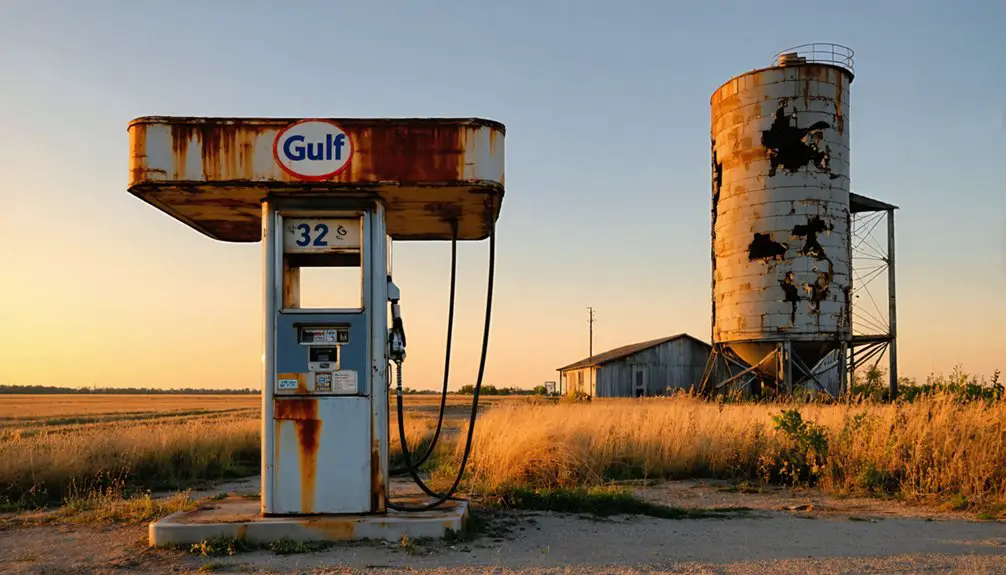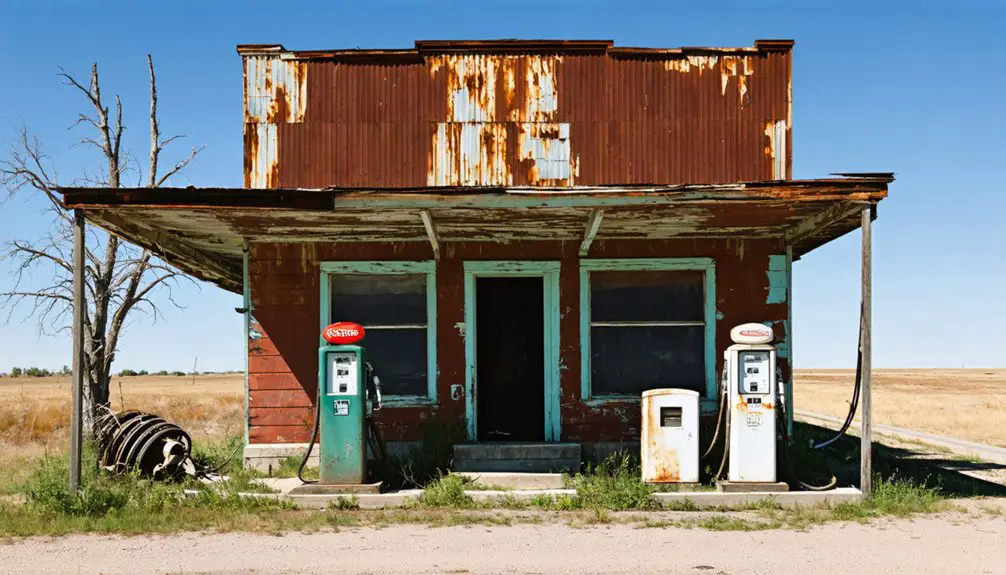You’ll find Tuskegee in Creek County, Oklahoma, where it once thrived as a bustling farming community in the early 1900s. The town’s decline began with agricultural hardships during the Dust Bowl and worsened when major transportation routes bypassed the area. By the mid-20th century, the shuttering of the post office and exodus of residents sealed its fate. The remnants of this ghost town hold fascinating tales of boom-and-bust cycles in Oklahoma’s settlement era.
Key Takeaways
- Tuskegee was a former settlement in Creek County, Oklahoma that became a ghost town due to economic decline and infrastructure changes.
- The town’s decline accelerated when major highways bypassed it, particularly after the 1957 bypass diverted traffic away from local businesses.
- Agricultural crisis during the 1931 drought and Dust Bowl forced many residents to abandon their farms and seek opportunities elsewhere.
- The community once thrived with a general store, church, and schoolhouse serving as social hubs before its eventual abandonment.
- Few physical structures remain today, with the town’s history primarily preserved through local historians and ghost town enthusiasts.
The Rise and Fall of a Rural Community
While many Oklahoma ghost towns followed similar patterns of boom and bust, Tuskegee’s story exemplifies the harsh economic realities that faced rural communities in the early 20th century.
The post-statehood era saw many towns succumb to resource exhaustion, marking a pattern that would repeat across Oklahoma’s landscape.
You’ll find that Tuskegee’s fate was sealed when it missed essential railroad connections, limiting its access to critical markets and transportation networks that could’ve sustained its growth.
Much like the Cherokee population that characterized early Yonkers, Tuskegee’s community identity struggled against mounting economic pressures as surrounding areas with better infrastructure drew away residents and businesses.
Unlike towns that could rely on natural resources or strategic locations near jurisdictional boundaries for economic resilience, Tuskegee couldn’t maintain its foothold.
Tuskegee lacked the vital resources and strategic position that helped similar towns survive Oklahoma’s harsh economic climate.
Without the economic advantages that sustained other Oklahoma settlements, the town gradually lost its population to urban areas offering greater opportunities, leaving behind empty buildings and fading memories.
Historical Timeline and Key Events
The story of Tuskegee’s transformation from a thriving community to a ghost town unfolds across several defining moments in Oklahoma’s territorial and early statehood periods.
Like many Oklahoma settlements, Tuskegee’s historical significance emerged during the economic shifts that shaped the region’s landscape. Similar to the town of Kusa, which at its peak boasted 3,500 residents, these communities represented dreams of economic prosperity. You’ll find its story intertwined with the broader pattern of Oklahoma’s 2,000 ghost towns, where communities rose and fell with changing fortunes.
The cultural impact of Tuskegee’s decline mirrors the challenges faced by Native American sites like Hickory Ground, where preservation efforts clashed with development pressures. Just as Muscogee Creek people had inhabited these lands for millennia, their displacement marked a profound shift in the region’s cultural landscape.
As transportation routes evolved and resources depleted, Tuskegee joined the ranks of countless other communities that couldn’t adapt to Oklahoma’s changing economic tides, ultimately succumbing to the forces that transformed bustling towns into silent remnants of the past.
Life in Early Tuskegee
You’d find the early Tuskegee people deeply engaged in farming maize along the riverbanks, using stone tools to cultivate their primary food source.
The community would gather at central points in their villages for important ceremonies marking planting and harvest seasons, with these ritual spaces serving as the heart of their social and spiritual life.
Your daily activities would revolve around communal farming, resource gathering, and participating in shared cultural practices that strengthened the bonds between community members. The tribe maintained extensive intertribal trade networks that reflected their complex social organization. Historical records require careful source navigation to accurately trace the community’s development.
Daily Rural Activities
Life in early Tuskegee revolved around a demanding mix of agricultural and oil-related activities, with residents typically rising before dawn to tackle their daily responsibilities.
You’d find yourself engaged in subsistence farming, tending to corn and wheat fields while managing livestock husbandry with cattle and hogs. If you weren’t working the land, you might’ve been hauling water, chopping firewood, or heading to the oil fields for dangerous but profitable work. Disease spread rapidly through the community due to poor sanitation conditions in the overcrowded living spaces. The promise of quick oil wealth drew thousands of hopeful workers to the area.
Your daily routine would’ve included preserving food through canning and salting, trading goods with neighbors, and maintaining essential equipment.
When harvest season peaked, you’d join forces with fellow community members, sharing labor and resources. You’d rely on horses for transportation and face the challenges of limited communication in this rural setting.
Community Gathering Spots
Despite long days of agricultural labor and oil field work, early Tuskegee residents found time to gather at several key locations throughout their small community.
You’d find the general store bustling with activity as townspeople exchanged news and goods, while the local church served as the heart of weekly social interactions.
The schoolhouse transformed from a daytime educational center into an evening venue for dances and town meetings. Similar to towns like Beer City, residents gathered to socialize and unwind after long workdays.
Much like the Route 66 culture that would later develop, these gatherings fostered a strong sense of camaraderie among neighbors.
Community traditions centered around seasonal celebrations, with harvest festivals and holiday gatherings drawing everyone together.
You might’ve caught up on local news at the post office or joined your neighbors for impromptu storytelling sessions on front porches.
Farmer’s markets and trading days provided opportunities for both commerce and conversation, weaving together the social fabric of this close-knit Oklahoma town.
Geographic Location and Natural Features
Located in Creek County, Oklahoma at 35.653°N latitude and -96.281°W longitude, Tuskegee sits in the northeastern part of the state among rolling plains and deciduous forests.
You’ll find the town’s geographic significance reflected in its elevation of 700-900 feet above sea level, with soil types perfect for farming and natural resources that supported early settlement.
The region’s humid subtropical climate brings hot summers and mild winters, while spring rains nourish the mixed landscape of grasslands and forest patches.
Though Tuskegee itself doesn’t have direct river access, the nearby Canadian River‘s historic presence, including features like Younger’s Bend, shaped the area’s development.
The construction of Lake Eufaula Dam in 1964 later altered these waterways, leaving lasting changes to the regional geography.
Economic Factors Behind Abandonment

You’ll find that Tuskegee’s economic decline began when major highways bypassed the town, redirecting essential commerce away from local businesses that once served travelers.
The town’s agricultural base deteriorated as family farms consolidated into larger operations and younger generations moved to urban areas for better opportunities.
Local industries, unable to compete with larger markets and lacking reliable transportation connections, gradually shuttered their operations, leaving Tuskegee without sustainable employment options.
Transportation Routes Changed
While Tuskegee initially flourished due to its railway connections in the early 1900s, significant changes to transportation routes would ultimately seal the town’s fate.
You’ll find that the transportation evolution hit Tuskegee particularly hard, with its route significance diminishing through several devastating changes:
- Route 66’s construction initially boosted the local economy, but a 1957 bypass diverted traffic away from town.
- The Interstate Highway System’s development further isolated Tuskegee from major traffic flows.
- Railroad service decline eliminated essential freight and passenger connections.
The town’s dependency on transportation-based commerce proved fatal when these changes occurred.
Without reliable access to markets and travelers, businesses couldn’t survive.
Like many Oklahoma towns of its era, Tuskegee’s prosperity was inextricably linked to its position along major transit routes – when those routes changed, the town’s decline became inevitable.
Agricultural Base Collapsed
The agricultural collapse that devastated Tuskegee struck even harder than the transportation changes.
You’d have seen the first signs in 1931 when the devastating drought hit, transforming the region’s once-fertile fields into a barren wasteland. Poor agricultural practices had left the topsoil exposed, and when the Dust Bowl storms came rolling in, they stripped away what little productivity remained.
As if nature’s fury wasn’t enough, the Agricultural Adjustment Act of 1933 dealt another blow. Local landowners, keen to collect government payments, began evicting tenant farmers who’d worked these lands for generations.
With farm income plummeting by 64% and no safety net in place, you’d have watched your neighbors pack up and head west, joining the 440,000 Oklahomans who abandoned their homes in search of better opportunities.
Industries Left Town
When oil production began to wane in the late 1920s, Tuskegee’s industrial backbone crumbled alongside dozens of other Oklahoma boomtowns. The economic shifts that followed hit the town hard as larger oil corporations consolidated operations and moved toward urban centers.
You’d have seen dramatic industry closures that left workers with few options but to seek employment elsewhere.
- Independent contractors and small operators couldn’t compete with big oil companies
- Essential services, including the post office, shuttered as population declined
- No replacement industries emerged to sustain the local economy
Like many single-industry towns of that era, Tuskegee couldn’t survive the shift from independent operations to corporate consolidation.
Without economic diversification, the town’s fate was sealed – another victim of Oklahoma’s boom-and-bust cycle that transformed vibrant communities into ghost towns.
Present-Day Remnants and Legacy

Modern visitors searching for Tuskegee’s physical remnants will find little evidence of this once-active Oklahoma settlement. Unlike some preserved ghost towns in the region, Tuskegee’s remaining structures have largely vanished, succumbing to time, demolition, or repurposing. You won’t find dedicated museums or maintained landmarks here.
The town’s cultural memory lives on primarily through local historians and ghost town enthusiasts who document Oklahoma’s boom-bust settlement patterns.
While nearby communities like Ringo maintain a few adapted buildings from their heyday, Tuskegee’s site has likely merged into agricultural land or private property.
What’s left might include scattered foundations or historical markers, but they’re typically overgrown and difficult to access. The site serves as a quiet reminder of early 20th-century economic changes in Oklahoma.
Frequently Asked Questions
Are There Any Ghost Stories or Supernatural Legends Associated With Tuskegee?
You won’t find documented ghost sightings or haunted locations in Tuskegee, though like many Oklahoma ghost towns, locals occasionally share unverified tales of mysterious sounds in abandoned buildings.
Can Visitors Legally Explore the Remaining Structures in Tuskegee?
You can’t legally explore Tuskegee’s structures without permission, as they’re on private or tribal lands. Legal access requires approval from property owners or tribal authorities under current exploration guidelines.
What Native American Tribes Originally Inhabited the Tuskegee Area?
In this ancient land of countless moons, you’ll find the Creek (Mvskoke) Confederacy shaped the area’s tribal history, while the Tuskegee people, closely related to Alabama tribes, defined the cultural heritage around the rivers.
Were Any Famous People Born or Raised in Tuskegee?
You won’t find any famous residents documented from Tuskegee’s history. The ghost town’s limited records and notable landmarks don’t reveal any prominent individuals who were born or raised there.
Does Anyone Maintain Family Cemeteries or Gravesites in Tuskegee Today?
While Moore’s sister pays taxes as registered caretaker, you’ll find cemetery preservation is minimal. Family heritage sites remain neglected despite community concerns, with no formal maintenance plans protecting these important historical grounds.
References
- https://en.wikipedia.org/wiki/List_of_ghost_towns_in_Oklahoma
- https://www.okhistory.org/publications/enc/entry?entry=GH002
- https://okmag.com/blog/a-ghostly-site/
- https://www.youtube.com/watch?v=2Umqz7LrpyE
- https://www.okgenweb.net/~okwagone/roundup.html
- https://www.ghosttownsinoklahoma.com/post/ringo
- https://www.muscogeenation.com/justice-for-hickory-ground/hickory-ground-history/
- https://okcfox.com/news/local/oklahomas-secret-past-ghost-towns-of-oklahoma
- https://www.ebsco.com/research-starters/language-and-linguistics/tuskegee-tribe
- https://en.wikipedia.org/wiki/Muskogee



